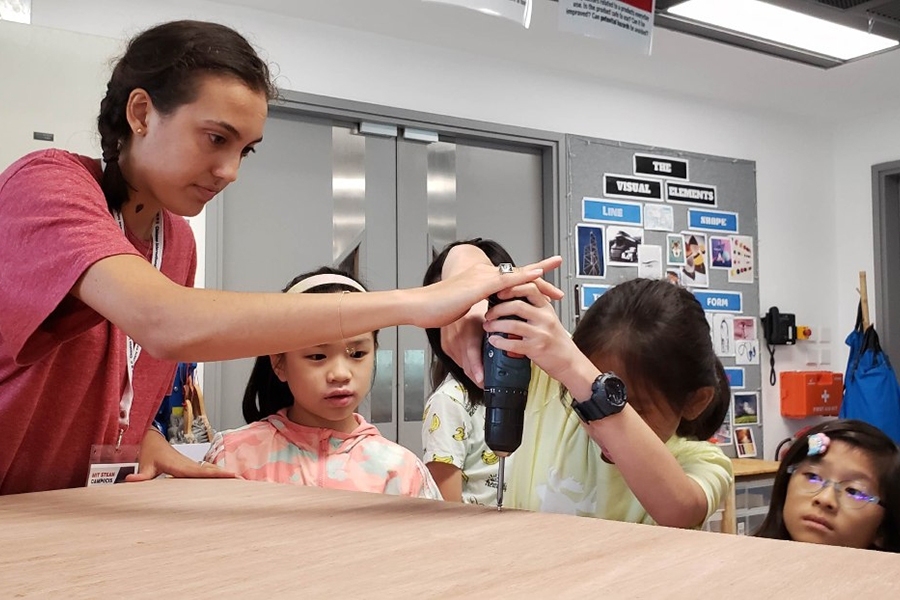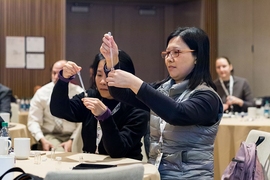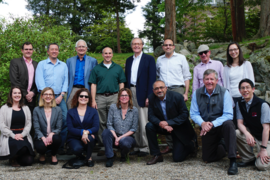MIT has long been a global leader in STEAM — science, technology, engineering, arts, and mathematics — education, driving innovation not only in the fields themselves but also in the ways it gets designed and delivered. Learning, of course, doesn’t just happen on campus or in a classroom setting. This summer, the MIT pK-12 Action Group, in collaboration with the Chinese International School (CIS) in Hong Kong, held its second annual MIT STEAM camp, bringing faculty, staff, and students together with just over 200 middle-school aged students and 30 teachers from the area for two weeks of hands-on learning.
According to pK-12 Action Group co-chair Professor Eric Klopfer, the group’s goal is “to create programs that engage growing numbers of diverse learners and educators through design, research, and implementation of educational innovations.” The project-based MIT STEAM camp aimed to do just that. Embodying the Institute’s “mens-et-manus” (mind-and-hand) learning approach, students in Hong Kong learned from various hands-on activities and explored the use of digital technologies and tools (such as Scratch, among others) to promote creativity, invention, and collaboration.
The theme of this summer’s MIT STEAM Camp was “Into The Water,” drawing inspiration from the UN Sustainable Development Goals. The six learning modules used in the program were developed by groups across MIT’s campus. The Edgerton Center, for instance, helped develop “Engineering with Water,” while an alumna of the MIT-Woods Hole Oceanograpic Institute Joint Program and MIT employee developed “Algae in our backyard: An ArtScience Exploration.” Other modules included observing small ocean crustaceans, understanding the effects of ocean acidification, and programming an EEG-driven “boat” (with Lego WeDo motors inside) that navigated around giant beach balls. Students also experimented and played with Scratch and other peripherals as an introduction to playful learning.
Participating campers then took these learning modules a step further, working collaboratively and applying the knowledge and skills they acquired to designing and building innovative projects. By the end of the two-week camp, students built projects ranging from board games to portable microscope projectors to two-tier structures that generated electricity through a dam.
Teachers learn, too
There was also a strong professional development component to the MIT STEAM camp. As part of the pK-12 Action Group’s mission, teachers participated in educator workshops parallel to the student campers. Led by the MIT team, local educators were exposed to the pedagogies and practices that drove the development of the camp’s modules, including approaches to have students experiment, build working models, make mistakes, and learn through iteration.
Joe Diaz '10, pK-12 Action Group program coordinator, explained that the teachers “observe how project-based learning can be used and are hopefully inspired to create and implement their own STEAM projects in their own classrooms during the school year.”
The MIT STEAM Camp succeeded in building important new capabilities among various stakeholders. “I saw this when students who had never used a hand drill picked one up and learned to drive a screw into a piece of wood,” explained Diaz. “I saw this when teachers realized that they could build working circuits that could be used to supplement their classroom activities. I saw this when our MIT student facilitators realized that they had empowered their students to make their ideas a reality, even in their short time together.”
New approaches to learning
Local students and teachers, as well as the MIT team, “came away from the MIT STEAM camp with a new way to look at how learning happens, one that combines learning while doing and connects to students’ interests and passion,” said Claudia Urrea PhD '07 PhD, associate director of pK-12 at the Abdul Latif Jameel World Education Lab (J-WEL) and founder of the STEAM Camp. “This is possible when students from different ages and schools get together around projects they care about and propose their own solutions to issues related to their local context.”
The eleven MIT student facilitators who traveled to run the modules in the classrooms were also invaluable. Their unique styles of teaching directly impacted the way the modules took shape. They worked directly with the Hong Kong students, bringing the modules to life.
Going from classroom learning about water to actually building a model of a hydroelectric dam, as STEAM Camp students and teachers did, was much more than an achievement of design. It holds the promise of becoming a template for how camp participants learn and teach for today and tomorrow, spreading MIT’s “mens-et-manus” approach to learning to different parts of the globe.
The STEAM Camp was made possible by the generous support of Vic Lee.









